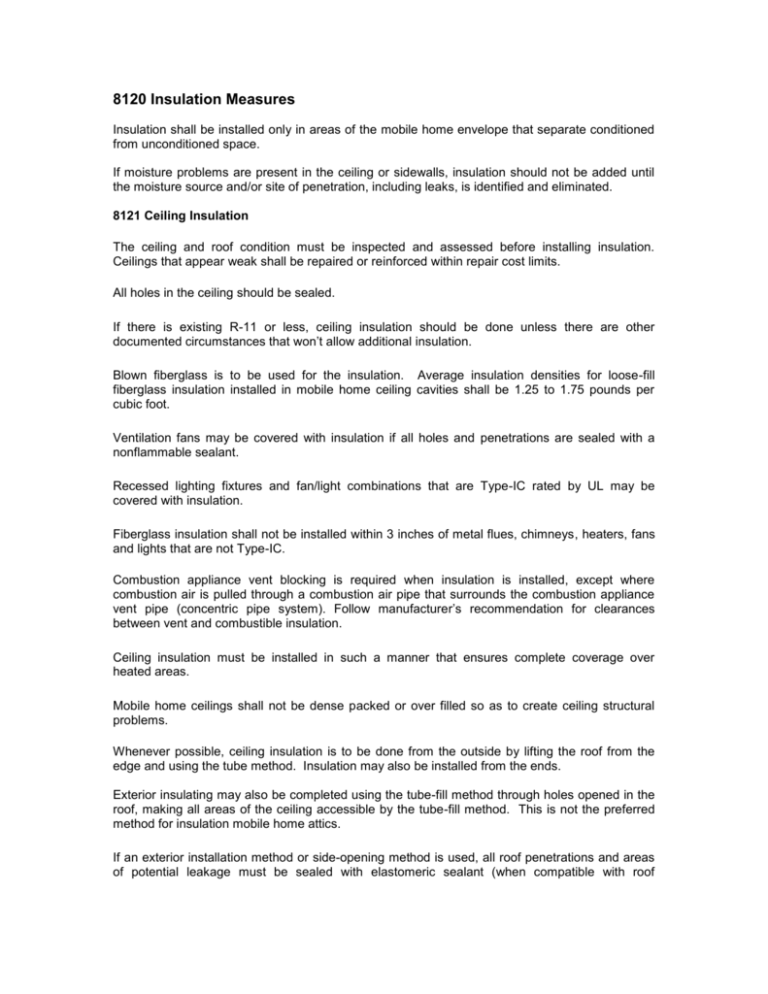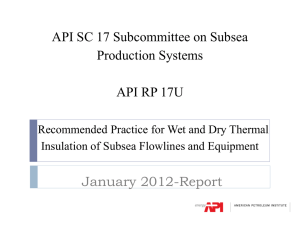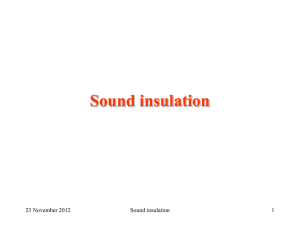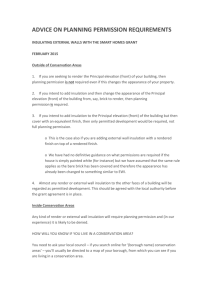8120 Insulation Measures
advertisement

8120 Insulation Measures Insulation shall be installed only in areas of the mobile home envelope that separate conditioned from unconditioned space. If moisture problems are present in the ceiling or sidewalls, insulation should not be added until the moisture source and/or site of penetration, including leaks, is identified and eliminated. 8121 Ceiling Insulation The ceiling and roof condition must be inspected and assessed before installing insulation. Ceilings that appear weak shall be repaired or reinforced within repair cost limits. All holes in the ceiling should be sealed. If there is existing R-11 or less, ceiling insulation should be done unless there are other documented circumstances that won’t allow additional insulation. Blown fiberglass is to be used for the insulation. Average insulation densities for loose-fill fiberglass insulation installed in mobile home ceiling cavities shall be 1.25 to 1.75 pounds per cubic foot. Ventilation fans may be covered with insulation if all holes and penetrations are sealed with a nonflammable sealant. Recessed lighting fixtures and fan/light combinations that are Type-IC rated by UL may be covered with insulation. Fiberglass insulation shall not be installed within 3 inches of metal flues, chimneys, heaters, fans and lights that are not Type-IC. Combustion appliance vent blocking is required when insulation is installed, except where combustion air is pulled through a combustion air pipe that surrounds the combustion appliance vent pipe (concentric pipe system). Follow manufacturer’s recommendation for clearances between vent and combustible insulation. Ceiling insulation must be installed in such a manner that ensures complete coverage over heated areas. Mobile home ceilings shall not be dense packed or over filled so as to create ceiling structural problems. Whenever possible, ceiling insulation is to be done from the outside by lifting the roof from the edge and using the tube method. Insulation may also be installed from the ends. Exterior insulating may also be completed using the tube-fill method through holes opened in the roof, making all areas of the ceiling accessible by the tube-fill method. This is not the preferred method for insulation mobile home attics. If an exterior installation method or side-opening method is used, all roof penetrations and areas of potential leakage must be sealed with elastomeric sealant (when compatible with roof materials), or with other equivalent sealant, as necessary. Areas that are to be patched must be cleaned to the metal roof surface. With written permission from the owner, interior ceiling drilling may be used as the last method should an exterior insulating method not be feasible. If an interior drill-and-blow method is used for installing insulation, holes must be plugged and sealed properly. Plugs need to be aligned and blend with the ceiling. Plugs are to be placed so the entire ceiling will receive the desired amount of insulation. 8122 Sidewall Insulation The exterior siding and the interior wall materials must be inspected prior to the installation of insulation. Weak or damaged wall materials must be repaired or reinforced prior to installing insulation within program spending limits. Wall areas that are readily accessible should be loosened from the bottom and insulated with 1½” of vinyl faced fiberglass batts using a Plexiglas or equivalent to push batts up into the wall cavity. If a mobile home has aluminum wiring, sidewalls shall not be insulated. Only walls with a cavity of 3” or more should be considered for wall insulation. In a 3” wall, if there is an existing batt larger than 1”, no additional insulation should be installed. If it is a 4” cavity and there is an existing 2” batt, no further insulation should be installed. Documentation concerning why the walls were not insulated should be in the client file. Prior to and after insulating walls electrical outlets should be checked to make sure they are in working condition. Items hanging on the walls should be removed prior to insulating the walls to avoid breakage. Installing insulation above windows and doors is usually not feasible or cost-effective and is not required in mobile homes. Mobile home sidewalls shall not be dense-packed or over filled so as to create siding or interior wall structural problems. 8123 Floor (Belly) Insulation 8123.01 Floor Insulation Requirements Inspect the floors from the interior to determine if there are any holes or penetrations to be repaired before insulating. Belly cavities must be inspected to determine the location of the plumbing, any existing plumbing leaks, and the R-value of existing insulation. Leaks should be fixed prior to weatherization. Duct leaks should also be sealed before installing insulation. Belly rodent barriers must be inspected for general condition, structural strength, and major air leakage, prior to installing insulation. Necessary belly rodent barrier repairs must be made if additional insulation will be added or if holes in the belly allow significant air movement between the belly cavity and the outside atmosphere. Fiberglass insulation is to be used to insulate the mobile home underbelly. Cellulose is not to be used. Average fiberglass insulation densities for loose-fill insulation installed in mobile home bellies shall be 1.25 to 1.75 pounds per cubic foot. Due to some mobile homes having extended warranties, if the mobile home is less than 15 years old it will be at the evaluator’s discretion whether or not to insulate the underbelly. If there is less than R-19 existing or less, underbelly insulation should be done unless there are other documented circumstances that won’t allow additional insulation. All areas not occupied by ducts, plenums, or other obstructions shall be insulated. If water pipes are located at the bottom of the belly rodent barrier and it is not possible to get at least two inches of insulation between the pipes and the rodent barrier, then the following must be attempted, if cost effective and feasible: The pipes must be insulated with additional insulation, either inside the belly or on the exterior of the rodent barrier, or The pipes shall be moved closer to the floor above or the insulation above the pipes should be removed. Belly insulation must be installed in such a manner that ensures complete coverage under heated areas. Bellies shall not be dense-packed or over filled so as to create undue stress on the belly rodent barrier. Holes that have been made in belly rodent barriers for the installation of insulation must be patched and sealed. Rim joists may not be drilled if they are determined to be a structural component of the foundation support system. 8123.02 Underbelly Insulation Methods METHOD 1 - Belly-Board Penetration When insulation has to be installed from underneath the belly, the installation of a 6-mil vapor barrier on the ground by the first person to go underneath is preferred, in order to reduce health risks to the installers from animal feces. When insulating from underneath, the use of insulation hose or a large diameter fill tube is preferred. Holes shall be spaced and sized to accommodate the directional nozzle or fill tube. The maximum insulation travel beyond fill tube or nozzle shall be no more than two (2) feet. Flexible fill tube shall not be more than 2' shorter than the length of the cavity being filled. The preferred methods of securing belly patches are through the use of adhesives, clinch staples, screws and lath strips whenever possible to provide a lasting patch. Preferred patching materials for large holes in belly rodent barriers include insulated sheathing board, fiberboard, and nylon reinforced belly bottom material specifically manufactured for mobile homes. Ductwork shall be inspected for insulation that might have accidentally entered during insulation work. METHOD 2 – Rim Joist Penetration Rim joists may not be drilled if they are determined to be a structural component of the foundation support system. Rim joist penetration is preferred when the joist size and condition allow for safe and proper installation. The trim on the bottom of the exterior wall shall be removed to expose the rim joist. Rim joist access shall not be used if it will weaken or damage the mobile home. Care must be taken to avoid damage to plumbing and electrical lines attached or adjacent to the rim joist. Rigid or flexible fill tube shall not be more than 2’ shorter than the length of the cavity being filled. Upon completion of insulation work, rim joists that have been drilled shall be plugged with a wood plug. The plug shall be sealed in the hole with an adhesive compound. Ductwork shall be inspected for insulation that might have accidentally entered during insulation work. 8124 Ground Cover Ground cover shall be installed whenever possible.







